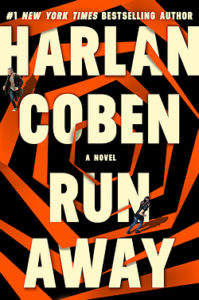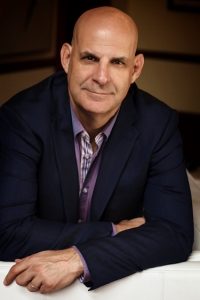For the past 28 years, Harlan Coben has been providing readers with a welcome mix of suspense, humor, and razor-sharp storytelling. His newest novel, Run Away, revolves around Simon Greene, a Wall Street financial advisor who hasn’t seen his drug-addicted daughter, Paige, in six months. When he finally finds her again, she’s nearly unrecognizable, and when he approaches her, she runs away. Simon follows in what becomes a dangerous and complex trail of secrets, violence, and deception. The Strand Magazine had a chance to talk with Coben about Run Away, which is slated for release on March 19, to learn more about the work ethic that has helped drive his success.
The Strand: How long after Don’t Let Go did you get the idea for Run Away?
Harlan Coben: The idea actually came to me a few months after finishing up on my show, Safe. After I finish a project, the standard procedure is that it takes me around three months to come up with the idea for the next one. That’s the pattern I’ve been working with now for the past 31 books.

TS: Is there a specific event that spearheaded the main idea for Run Away?
HC: In this case, it was a number of ideas I had that all came to me around the same time. I wanted to write about the trials of a family in which a child is dealing with drug addiction. I also wanted to write about these new DNA and genealogy websites, and I had an interest in writing about a cult. So I had these three ideas, and sometimes I’ll take one, sometimes I’ll take two, and sometimes I’ll take all three as I did in this case. So all of those were running through my head and then I was sitting in Central Park, the same place as my character, and I was watching a musician playing some John Lennon on the guitar, and I started to ask, “What if?”
TS: In this book, you’re working with three parallel narratives that start to connect as the reader gets further into the story. As the pieces all start to come together, you almost want to go back to the beginning and look for the clues that were presented along the way. How in-depth is the process of mapping out the structure of your story?
HC: It’s sort of what I do. In my mind, they’re all already connected because I already know the connections, so I just look at it like I’m telling the story from different viewpoints, and eventually all the characters will meet up. I hope the audience is asking themselves those sorts of questions while they read the book. I hope they’re interested in the hitmen in the story, and not just their misgivings but their conversations as well.
TS: Part of Simon’s journey in the book is seeing how far he’s willing to go to save his daughter. Is the audience’s sympathy with the character something you’re mindful of while writing a protagonist who falls somewhere in the gray area between hero and villain?
HC: I’m not really conscious of anything like that when I’m writing. I’m just really trying to write the best story I can. I don’t typically stop along the way to say, “Oh no, he’s going to lose the audience’s sympathy.” I believe that leads to more formulaic writing. The thing about fiction in general is that your hero is traveling down the road of life and confronting the obstacles in his or her way. How you overcome those obstacles is basically what all narrative concerns. What’s really going through my head as I write is, “Okay, here he is traveling down this road; what’s he going to come across next?” I don’t really structure in a traditional sense. I just try to figure out what’s going to happen next.
TS: Your books are often classified as “domestic thrillers.” How has your relationship with writing this kind of thriller evolved since your family has grown older?
HC: It’s not really something I’m conscious of, but I do find that a lot of the characters in my books are just a few years behind me. So when I first started to write Myron Bolitar, he was 20, as was I. Now with Run Away, all four of my kids are older than the character in the book. But there was certainly a time when my books had characters with younger kids, so it does sort of reflect what’s going on in my life, even if the characters are usually behind by a few years. I’ve always found that life informs what you write. I usually scoff at the notion of “write what you know,” but the fact is that you kind of end up doing that unconsciously. Whatever is happening in life has a way of manifesting in the book.
TS: How has getting involved in the world of film and television in the past few years changed the way you write fiction? Are there any lessons from film that you’ve brought over to prose writing?
HC: Surprisingly, not much. Both mediums are storytelling, but there are huge differences, one being that film and television both revolve around visual storytelling, while my books mainly take place in people’s heads. Another huge difference is that one medium is collaborative and one is done completely alone. For me, the two different kinds of writing spur on one another. I’m naturally an introvert, and when you write 31 novels, you spend a lot of time alone in a room. But I’m a socially adept introvert, so I do like being out in the world, too. So I was just in Manchester watching a table read for my new show, The Stranger, on Netflix. So I’m there and I’m meeting the cast and the crew, it’s a lot of energy and I’m loving it, but as soon as I get back home, I say, “I’ve got to go crawl into a room and be by myself for a while.” So they kind of both feed the other.
TS: Have you started brainstorming your next book at all?
HC: I actually started writing the next one a couple months ago, and I’d say I’m about halfway through it. I mostly start writing around October or November, and then aim to have it turned in by the summer. So the one I’m working on now is actually due in a few months. I’ll be on tour for Run Away for a little bit, and I’m very excited about that. It’s somewhere around nineteen cities, and so far the response for the book has been great. This is probably the most extensive tour I’ve done within the past nine or ten years. I’m excited to see what people think of it.

With over 70 million books in print worldwide, Harlan Coben is the perennial #1 New York Times author of thirty novels including RUN AWAY, FOOL ME ONCE,TELL NO ONE, NO SECOND CHANCE and the renowned Myron Bolitar series. His books are published in 43 languages around the globe. His newest novel, RUN AWAY, publishes March 19, 2019 in the US.
